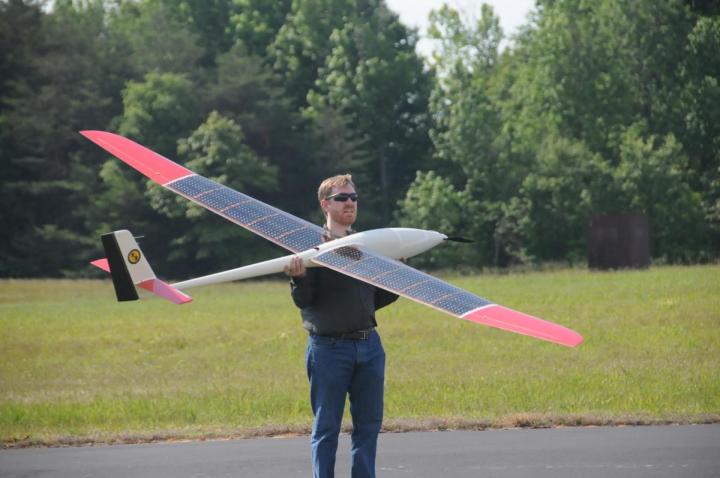Businesses can acquire Navy technology through patent license agreements

Credit: Naval Research Laboratory
A Navy scientist has re-engineered the software that allows long-endurance drones to powerlessly climb into the sky on bubbles of warm air.
In a U.S. patent application published on May 2, Aaron Kahn, an engineer working on the Autonomous Locator of Thermals (ALOFT) project at the Naval Research Laboratory, reported that he has extensively tested the new software that detects and estimates the position of thermals, i.e., rising columns of warm air that birds use to stay aloft without flapping their wings.
Unlike birds, soaring drones need the benefits of thermal detection and position estimation software as the warm air tends to drift relative to the ground due to winds.
Prior systems relied on batch estimation processes that “require storing large arrays of data, which is not ideal for operation on small microcontrollers with limited memory resources.”
Kahn’s new soaring software uses extended Kalman filtering, a kind of algorithm already used by the Navy for navigating submarines and cruise missiles. Now it can help orbit drones like the tiny CICADA glider or long-endurance solar-soaring UAVs that might also have photovoltaic or fuel cells feeding battery-powered propellers.
Solar-soaring UAVs don’t need large batteries because they harvest energy from the environment using intelligent software, in the case of the autonomous soaring algorithms, or lightweight, integrated solar panels that capture energy from the sun.
“This technique enables an increase in range and endurance of an aircraft without having to add additional fuel/batteries,” according to the Navy’s patent application. “It is possible that the technique could be implemented in an aircraft without requiring any changes to its hardware, only software.
Furthermore, the technique is applicable to both manned and unmanned aircraft. Because the method is parameterized, it can be quickly tailored to a variety of aircraft types.”
Now that the patent application has been published, qualified businesses can evaluate the technology with the intention of licensing it for use in their drones.
Brian Metzger, a senior technology manager at TechLink, guides businesses through Navy tech evaluation and licensing at no charge.
He said there’s a handful of promising solar-soaring UAV companies that will want to evaluate Kahn’s work, but also manned aircraft and glider manufacturers.
“This is really for anyone building air vehicles that can harness thermals,” Metzger said.
###
Businesses interested in evaluating and licensing the technology can contact Brian Metzger at [email protected] or by telephone at 406-994-7782.
Media Contact
Troy Carter
[email protected]
Original Source
https:/



